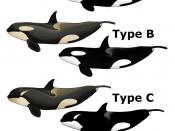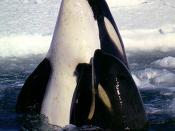Killer whales inhabit the cooler waters of both the western and northern hemispheres, where sea life is most abundant. Killer whales are mainly black or deep brown in color, having large white patches on their lower jaw, belly, and above their eyes, and a lighter off-white saddle patch just under and behind their dorsal fins. They are quite large mammals, with females growing to up to 8.5 m (27.5 ft) long, and males to up to 9.8 m (31.9 ft) long as they become fully-grown adults. All killer whales have a large dorsal fin protruding out of their mid-back, noting that the adult male's dorsal fin continues to grow until it is the shape of a triangular "sail" measuring up to 1.8 m (5.9 ft) tall. The flippers are also unique; they are large and oval shaped, making them unlike those of any other whale.
Killer whales mainly feed on fish, squid, and marine birds including penguins, seagulls and pelicans, though they may sometimes tackle a blue whale, the largest marine mammal on Earth!
In some parts of the world, killer whales are fussier about their diet; in the Pacific Northwest of the United States and Canada, for example, local populations of killer whale feed exclusively on salmon and trout while other groups of the same species feed on harbor seals, porpoises and sharks.
Killer whales live in schools ranging in size from two to well over fifty members; they tend to cooperate during hunting.
In several places in the southern hemisphere, these whales sometimes rest briefly on shore as they rush to take seals or sea lions laying on the sand. Killer whales may scout a several hundred square kilometer area in search of prey, rapidly covering large areas in a matter of days!
Killer whales mate in the...


